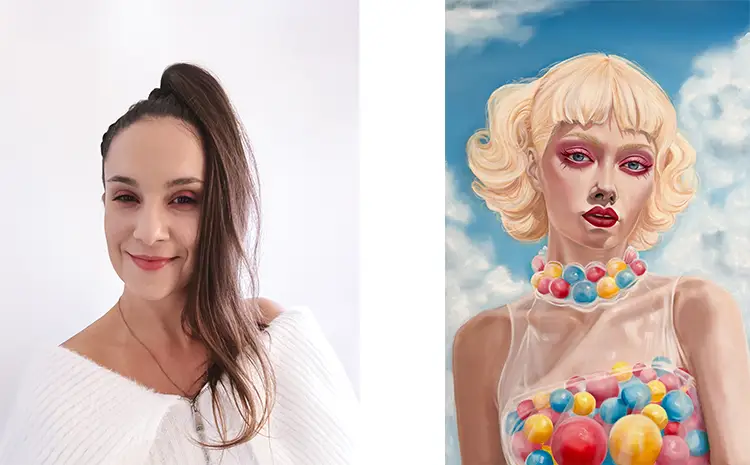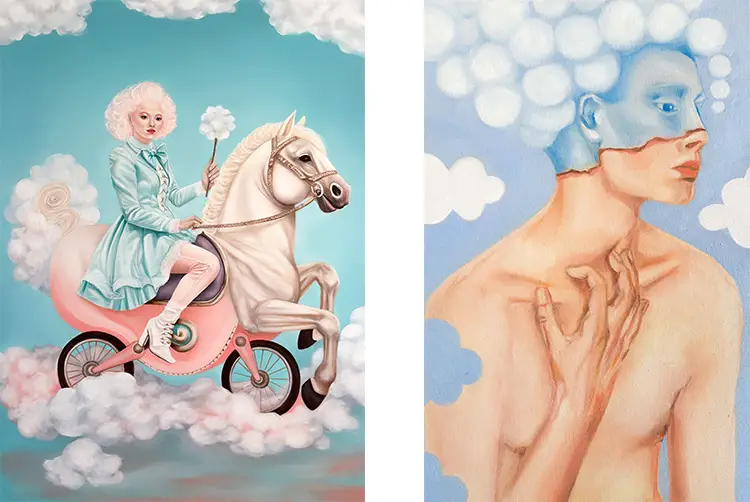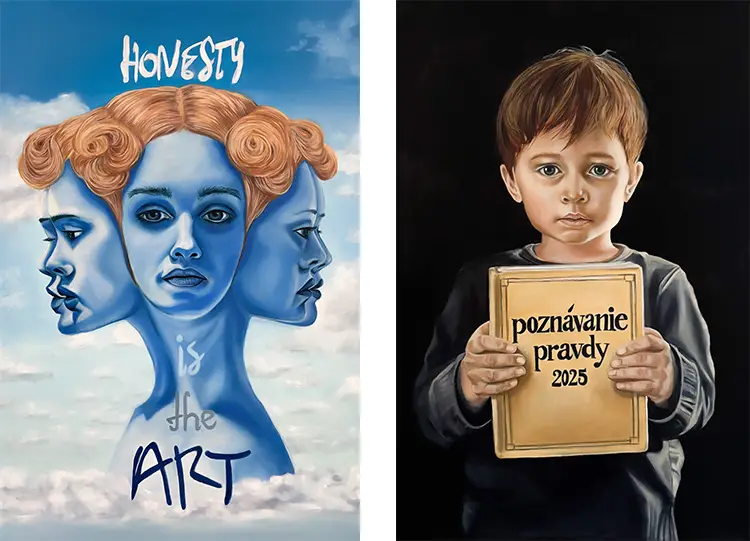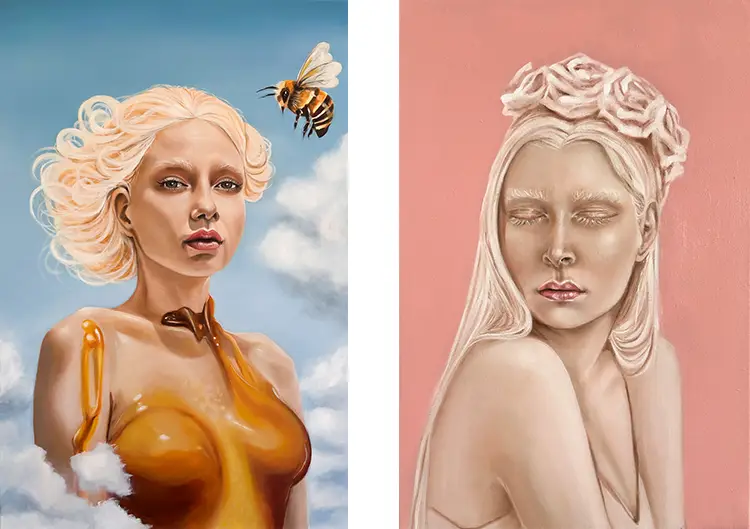“To be an artist is not a career. It is a state of being.”
The Village of Memory and the Artist It Made
Maria Mazuchova’s work stands as a quiet rebellion against the mechanized pace of the modern world—her aesthetic breathes with the stillness of forests, the glow of sunsets, and the intimacy of remembered love. Born in Banská Bystrica, Slovakia, and now based in Bratislava, Mazuchova is a self-taught painter, photographer, and graphic designer whose art is steeped in the natural and emotional landscapes of her upbringing. What distinguishes her is not only the quality of her visual execution but also the way her work listens—deeply, attentively—to the echoes of a past that never truly left. Her visual voice is inseparable from the place that nurtured her spirit: a village called Hrochot, where childhood innocence met the raw abundance of nature.
Hrochot was not just a geographical location for Mazuchova—it was a full sensory world, an environment that infused her young consciousness with notions of sacred beauty and emotional truth. At the heart of this village was her grandparents’ house, a large home with a hand-built lake, animals of all kinds, and a German shepherd named Bojar—actually a lineage of dogs, all bearing the same name. It was here, among goats, chickens, snow-capped peaks, and the serenity of natural springs, that she first encountered the authenticity and simplicity that would become the foundation of her aesthetic instincts. The exaggerated purity of that environment would later translate into her fascination with emotional clarity and spiritual resonance in visual form. Even the wild, untamed affection she gave to the local cats—regardless of parental protest—reveals the essence of her artistic ethos: love that does not measure, that simply exists.
This formative backdrop provided more than nostalgia; it carved the contours of an artist who equates beauty not with embellishment but with truth. Her reverence for the land and the people in it—especially her lifelong best friend who also came from the village—created a psychological reservoir she still draws from today. In her words, the place taught her what beauty really is: not perfection, but a kind of spiritual coherence between people, nature, and feeling. That comprehension was not learned; it was remembered, and her art acts as a method of recalling that sacred alignment. For Mazuchova, creativity is less about invention and more about returning—again and again—to something that remembered her before she even knew what she was becoming.

Maria Mazuchova: The Calling That Would Not Wait
For Maria Mazuchova, art was never a professional objective—it was an identity she tried, and failed, to reject. Although her path to painting arrived unexpectedly, it was always part of her internal compass, a truth she attempted to suppress until her body and soul began demanding that she listen. Her understanding of being an artist is far from romanticized; she considers it a way of existing rather than a line of work. To her, an artist is not someone who chooses to create, but someone born into a dialogue with the world that simply cannot be ignored. Denying that dialogue, as she discovered, leads to emotional and even physical dissonance. And so, she surrendered—first reluctantly, and then completely.
Ironically, painting was the one discipline she had resolutely dismissed. She enjoyed writing, photography, and design, but drawing and painting were, in her own mind, entirely beyond her skill set. Her aversion was so strong that she abandoned the idea of formal design education altogether, convinced that a lack of talent made such pursuits futile. That certainty began to unravel around the age of 28, during an impromptu afternoon with her siblings—playing with oil paints on a terrace. It wasn’t a serious artwork, just shared brushstrokes and playful splashes, but it marked her first encounter with the medium. Something about the experience stirred her, and soon after, she began buying her own paints, brushes, and canvases, quietly stepping into what would become her most profound form of expression. The act itself dismantled her critical mindset, forcing her to confront the possibility that she had been wrong about herself. What followed was not a sudden leap into mastery, but a sustained commitment to learning, exploring, and contemplating the essence of art as an emotional and spiritual experience.
Mazuchova’s embrace of oil painting transformed her approach to life and self-expression. Unlike watercolors, which she found limiting and incompatible with her aesthetic needs, oil paints offered her the flexibility and depth she needed to pursue her technically challenging, emotionally resonant visions. Her preferred style, which she terms “dreamy hyperrealism,” requires patience, nuance, and a certain reverence for the subject matter. Through oil, she found a vehicle capable of carrying her complex themes—ranging from femininity and societal expectation to existential musings and emotional integrity. In her view, the medium chose her, not the other way around. This conviction mirrors her larger philosophy: the path of the artist is revealed not through logic, but through surrender to intuition and experience.

Where Feeling Paints What the Eyes Cannot See
Maria Mazuchova’s artistic approach is centered on a belief that true creation originates not from thought, but from presence. She works from a place of internal stillness, seeking to move beyond cognitive interpretation and into the domain of pure emotional resonance. This methodology has led her to explore painting as an altered state—one in which the mind becomes quiet and the heart becomes the eye. Her work does not aim to impress with technical precision alone; it seeks to move, to stir something intimate and intangible in the viewer. She intentionally trains her awareness to observe her own thoughts, quieting them until what remains is a space from which unfiltered emotion can emerge.
The result is a body of work that often feels dreamlike and surreal, but never detached from emotional reality. Her pieces operate as emotional cues—visual containers of internal truths—rather than literal depictions of external life. Through the use of symbolism, light, and stylized forms, she constructs visual languages that invite viewers into shared contemplation. The colors she uses are emotionally coded: blues suggest inwardness, pinks reflect the complex performance of femininity, and golden tones represent vitality and essence. These elements are not decorative—they are psychological and philosophical instruments. The figures in her paintings often inhabit fantastical settings, but their expressions and gestures are deeply human, often echoing themes of awakening, confrontation, and inner reconciliation.
Mazuchova’s range of themes is vast but unified by emotional sincerity. Whether addressing societal expectations of women, the multiplicity of human experience, or the sacred nature of love and spirituality, her work consistently refuses simplification. In her view, art must speak from a place of inner alignment, and for this reason, she embraces variation rather than consistency in thematic content. Feminist undertones emerge in pieces like The Good, Good Girl and Too Sweet Too, while existential inquiries surface in works such as The Multiverse and Feelings. Regardless of the topic, the goal remains the same: to create images that serve as mirrors—offering viewers a moment of recognition, discomfort, or illumination that resonates beyond the canvas.

Maria Mazuchova: Honesty Is the Art
For Maria Mazuchova, creativity is less about mastering a technique and more about responding to a calling. Her admiration for artists like Salvador Dalí stems from this same ethos—a fascination with those who transcend the expected and dive into the limitless possibilities of perception. Dalí’s riddling surrealism and unapologetic weirdness inspire her because they dismantle constraints on the imagination, encouraging her to bypass conventional logic and embrace the irrational beauty of feeling. But her deepest artistic influence does not reside in the gallery—it stands in stone and glass. The basilica of Sagrada Familia, designed by Antoni Gaudí, holds a sacred place in her creative consciousness. To her, it is not just a structure, but a living testament to spiritual freedom and natural inspiration. It is art elevated to revelation.
Gaudí’s work resonates with her because it unites material and immaterial worlds. The branching columns, intricate facades, and shifting light within Sagrada Familia reflect not only craftsmanship but also an emotional ecology that mirrors her own ideals. Mazuchova sees in Gaudí’s vision an example of what it means to create with absolute honesty—a fusion of purpose, beauty, and truth. She aspires to channel a similar authenticity in her own work, not by imitating his style, but by embodying the courage it takes to let one’s inner world shape outer reality. This same spirit animates her dream project: a series of works—both written and painted—centered on the lives of her grandparents. Tentatively titled One Human Life, the project is envisioned as an intergenerational meditation on love, legacy, and interconnectedness. In her words, no life is ever just one—it is always the echo of many.
Her creative rhythm reflects a deep respect for internal timing and emotional balance. She values peace and sunlight in her workspace, and navigates distraction not with rigidity but with compassion. This philosophy of acceptance extends to her entire practice: she allows herself to drift when needed, trusting that inspiration returns most fully when not demanded. Whether working in long, focused stretches or brief, intuitive bursts, she honors the natural cadence of her creativity. Her process reflects her larger worldview: art is not a task to be completed, but a conversation to be continued. Through her evolving body of work, Maria Mazuchova invites us to enter that conversation—not with answers, but with presence, feeling, and above all, honesty.








